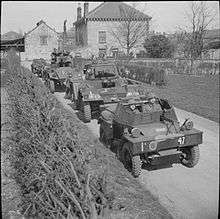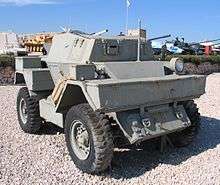Daimler Dingo
| Daimler Scout Car | |
|---|---|
.jpg) | |
| Type | Armoured car |
| Place of origin |
|
| Service history | |
| In service | 1940–1968 |
| Used by | British Commonwealth and associated foreign units in Second World War, other nations post war. |
| Wars |
World War II Malayan Emergency Portuguese Colonial War |
| Production history | |
| Designer | BSA |
| Designed | 1938/39 |
| Manufacturer | Daimler |
| Number built | 6,626 |
| Specifications | |
| Weight | 2.8 long tons (3 tonnes) |
| Length | 10 ft 5 in (3.18 m) |
| Width | 5 ft 7.5 in (1.715 m) |
| Height | 4 ft 11 in (1.50 m) |
| Crew | 2 |
|
| |
| Armour |
30 mm front 12 mm sides |
Main armament | .303 in Bren gun or a .55 in Boys Anti-tank Rifle[1] |
| Engine |
2.5 litre 6-cyl Daimler petrol 55 hp (41 kW) |
| Power/weight | 18.3 hp/tonne |
| Transmission | pre-selector gearbox, five gears forward and 5 gears reverse |
| Suspension | independent, coil spring, Wheeled 4x4 |
Operational range | 200 mi (320 km) |
| Speed | 55 mph (89 km/h) |
The Daimler Scout Car, known in service as the Daimler "Dingo" (after the Australian wild dog), was a British light fast four-wheel drive reconnaissance vehicle also used in the liaison role during the Second World War.
Design and development


In 1938 the British War Office issued a specification for a scouting vehicle. Three British motor manufacturers: Alvis, BSA Cycles and Morris were invited to supply prototypes. Alvis had been in partnership with Nicholas Straussler and provided armoured cars to the Royal Air Force, Morris had participated in trials and production of armoured cars, and BSA Cycles -whose parent Birmingham Small Arms (BSA) was involved in armaments - had a small front wheel drive vehicle in production.
Testing began in August 1938. All were of similar size and layout - rear engine and all four wheels driven. The Morris design was eliminated first - suffering from poor speed even after modification by its builders. The Alvis prototype - known as "Dingo" - could manage 50 mph over a cross country course but had a high centre of gravity.
The BSA prototype was completed in September and handed over for testing. By December it had covered 10,000 miles on- and off-road with few mechanical problems. Policy from the War Office changed to a requirement for better armour with the effect that an armoured roof was needed. As a consequence the BSA vehicle needed a more powerful engine and strengthened suspension. It was chosen over the Alvis and the first order (172 vehicles) for the "Car, Scout, Mark I" was placed in May 1939. The actual production was passed to Daimler, which was a vehicle manufacturer in the BSA group of companies.
The potential of the design was recognised, and it served as the basis for the development of a larger armoured car - a "Light Tank (Wheeled)" which would later become the Daimler Armoured Car.
The first pilot vehicle was built by the end of 1939, later to be officially designated 'Daimler Scout Car' but already known by the name of the Alvis design - the 'Dingo'.
Arguably one of the finest armoured fighting vehicles built in Britain during the war, the Dingo was a compact two-man armoured car, well protected for its size with 30 mm of armour at the front and powered by a 2.5 litre 55 hp straight six petrol engine was located at the rear of the vehicle.
One of the ingenious features of Dingo's design was the transmission which included a preselector gearbox and fluid flywheel that gave five speeds in both directions, another was a four-wheel steering system made possible by the H-drive drivetrain, giving a tight turning circle of 23 ft (7.0 m)
Inexperienced drivers found it difficult to control so rear-steering was deleted in later production at the cost of increasing the turning circle 65% to 38 ft (12 m).
The layout of the H-drive drivetrain contributed greatly to its low silhouette, agility and - an important consideration in any vehicle used in the reconnaissance role, an exceptionally quiet engine and running gear. Power was led forward to a centrally-located transfer box and single differential driving separate left and right hand shafts, each in turn running forwards and back to a bevel box powering each wheels. This extremely space-efficient layout resulted in a low-slung vehicle with a flat plate that allowed the Dingo to slide across uneven ground, but this feature made the Dingo extremely vulnerable to mines.
No spare wheel was carried, considered unnecessary because of the use of run-flat (nearly solid) rubber tyres rather than pneumatic types vulnerable to punctures. Despite hard tyres, independent coil suspension gave each wheel having approximately 8 inches (20cm) vertical deflection and coil springs all round gave a remarkably comfortable ride.
A swivelling seat beside the driver allowed the second crew member to attend to the No. 19 wireless set or Bren gun when required.
The Dingo remained in production throughout the war, but to bring other production resources into use, the design was passed to Ford Canada, where an equivalent vehicle (“Scout Car, Ford, Mk.I”, also called “Lynx”) was built a more powerful Ford V8 95 hp engine, transmission and running gear. The resulting vehicle, which superficially resembling the Dingo in general arrangement and body shape was physically larger (approximately a foot longer, wider and taller), a ton and a half heavier, less nimble (the turning circle had crept up to 47 feet) and was louder. While rugged and dependable it was not as popular as the Dingo, unsurprising given the intended use of covert intelligence-gathering.
Total production figures for each type were 6,626 for the Dingo (all marks) 1939-1945; and 3,255 for the Lynx 1942-1945.
Service
The Dingo was first used by the British Expeditionary Force (1st Armoured Division and 4th Royal Northumberland Fusiliers) during the Battle of France. It turned out to be so successful that no replacement was sought until 1952 with the production of the Daimler Ferret. Principal users were reconnaissance units with a typical late-war recce troop consisting of two Daimler Armoured Cars and two Daimler Dingoes. The vehicle was highly sought-after with damaged Dingoes often being recovered from vehicle dumps and reconditioned for use as private runabouts. One such 'off establishment' vehicle was rebuilt from two damaged Dingoes in Normandy, 1944, by REME vehicle fitters of 86th Anti-Tank Regiment, Royal Artillery. They operated this Dingo for about a week before a higher-ranking officer spotted it and commandeered it for himself.
Writing in 1968 author R.E. Smith said that all Dingoes had now been withdrawn from British service - except for one used as a runabout at an armoured establishment - but some might have remained in Territorial Army storage at that date.[2] Many were also purchased from Canada by the Union Defence Force after World War II, though few South African examples have survived to present day,[3] and were also procured in large numbers for Commonwealth patrols during the Malayan Emergency. Ten were purchased by the United States for liaison purposes during the Vietnam War, at least one turreted American prototype being tested with the 7th Cavalry Regiment.[4] In mid-1970s the Dingo was still being used by Cyprus, Portugal and Sri Lanka. Some may have been in reserve store with other minor nations. Surviving vehicles are now popular among historical re-enactors with reconditioned Dingoes commanding a good price.
Variants
Production went through 5 variants which were mostly minor improvements. 6,626 vehicles were produced from 1939 to 1945.
- Mk I
- original model with four-wheel steering and sliding roof.
- Mk IA
- as Mark I but with a folding roof.
- Mk IB
- reversed engine cooling air flow and revised armour grilles for radiator
- Mk II
- As the Mk IB but with steering on the front wheels only and revision of the lighting equipment.
- Mk III
- Produced with a waterproofed ignition system. No roof.

- Lynx Scout Car
- A closely related vehicle, the Lynx Scout Car, or "Car, Scout, Ford Mark I" was produced by Ford Canada in Windsor, Ontario. The Lynx design grafted a Dingo hull onto a chassis fitted with a conventional four wheel drive and running gear. While the engine was much more powerful the gearbox and suspension were inferior. The type entered service at some time around 1943.
- Mk I.
- Mk II - strengthened chassis, no roof. extra storage, revised engine grilles
Another Dingo clone, the Autoblinda Lince was developed by Lancia, Italy. In 1943-1944, 129 cars were built. They were employed by both German and RSI forces.
Notes
- ↑ 11th Hussars used twin 0.303 Vickers K machine guns
- ↑ Smith, R.E. British Army Vehicles and Equipment. Littlehampton Book Services Ltd, July 1968. ISBN 978-0711000209
- ↑ Scout Car, Canada - Lynx II (Museum exhibit), Saxonwold, Johannesburg: South African National Museum of Military History, 2014
- ↑ Icks, Robert. AFV Weapons Profile Vol 1 40 - US Armored Cars. Profile Publications 1972. ASIN: B0007BNFRC pp 21-22.
References
- Forty, George (1996). World War Two Armoured Fighting Vehicles and Self-Propelled Artillery. Osprey Publishing. ISBN 1-85532-582-9.
- White, BT, Armoured Cars, AFV No. 21, Profile Publishing
External links
| Wikimedia Commons has media related to Daimler Scout Car. |
- Car, Scout, Daimler Mark II (E1985.96) - tank museum accession record
- The Dingo on exhibit at the Tank Museum
- Ford Lynx Scout Car at mapleleafup.org
- Daimler Scout Car 'Dingo' wwiivehicles.com
- The Daimler Fighting Vehicles Project
- 1938 Performance report on Dingo
- Photo of New Zealand Div Cav Daimler Dingo in Italy, 1944
- Daimler Dingo/Ford Lynx Scout Car index - warwheels.net
- Surviving Dingo and Lynx Armoured Cars